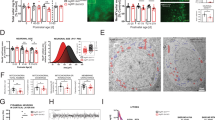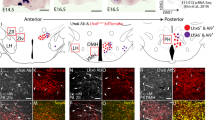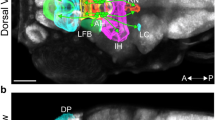Abstract
Hypothalamic neuron circuits regulating energy balance are highly plastic and develop in response to nutrient and hormonal cues. To identify processes that might be susceptible to gestational influences in mice, we characterized the ontogeny of proopiomelanocortin (POMC) and neuropeptide Y (NPY) cell populations, which exert opposing influences on food intake and body weight. These analyses revealed that Pomc is broadly expressed in immature hypothalamic neurons and that half of embryonic Pomc-expressing precursors subsequently adopt a non-POMC fate in adult mice. Moreover, nearly one quarter of the mature NPY+ cell population shares a common progenitor with POMC+ cells.
This is a preview of subscription content, access via your institution
Access options
Subscribe to this journal
Receive 12 print issues and online access
$209.00 per year
only $17.42 per issue
Buy this article
- Purchase on Springer Link
- Instant access to full article PDF
Prices may be subject to local taxes which are calculated during checkout


Similar content being viewed by others
References
Ogden, C.L. et al. J. Am. Med. Assoc. 295, 1549–1555 (2006).
Taylor, P.D. & Poston, L. Exp. Physiol. 92, 287–298 (2007).
Levin, B.E. Phil. Trans. R. Soc. Lond. B 361, 1107–1121 (2006).
Bouret, S.G., Draper, S.J. & Simerly, R.B. Science 304, 108–110 (2004).
Shankar, K. et al. Am. J. Physiol. Regul. Integr. Comp. Physiol. 294, R528–R538 (2008).
Saper, C.B., Chou, T.C. & Elmquist, J.K. Neuron 36, 199–211 (2002).
Cowley, M.A. et al. Nature 411, 480–484 (2001).
Ollmann, M.M. et al. Science 278, 135–138 (1997).
Schwartz, M.W. & Porte, D. Jr. Science 307, 375–379 (2005).
Altman, J. & Bayer, S.A. J. Comp. Neurol. 182, 945–971 (1978).
Shimada, M. & Nakamura, T. Exp. Neurol. 41, 163–173 (1973).
Broad, K.D., Curley, J.P. & Keverne, E.B. Dev. Neurobiol. 69, 314–325 (2009).
Cottrell, E.C. et al. Am. J. Physiol. Regul. Integr. Comp. Physiol. 296, R631–R639 (2009).
Nilsson, I., Johansen, J.E., Schalling, M., Hokfelt, T. & Fetissov, S.O. Brain Res. Dev. Brain Res. 155, 147–154 (2005).
Pinto, S. et al. Science 304, 110–115 (2004).
van den Top, M. et al. Neuroscience 144, 815–824 (2007).
Zinyk, D.L., Mercer, E.H., Harris, E., Anderson, D.J. & Joyner, A.L. Curr. Biol. 8, 665–668 (1998).
Balthasar, N. et al. Neuron 42, 983–991 (2004).
Fioramonti, X. et al. Diabetes 56, 1219–1227 (2007).
Chen, H., Simar, D., Lambert, K., Mercier, J. & Morris, M.J. Endocrinology 5348–56 (2008).
Acknowledgements
We thank L. Sussel, H. Wichterle and D. Accili for critical reading of our manuscript and helpful comments; R. Leibel for support and major funding for this project (RO1 DK52431-16); J. Overton for help with confocal imaging; L. Yang of the Diabetes and Endocrinology Research Center Pathology Core for cryosectioning and C. Liu of the Irving Institute Clinical and Translational Science Award, FACS core (National Center for Research Resources UL1 RR024156); M. Low for Pomc-GFP mice (University of Michigan Health Center), J. Elmquist for Pomc-Cre mice (Univerisity of Texas Southwestern Medical Center) and B. Lowell for Npy-hrGFP mice (Beth Israel Deaconess Medical Center) for generously providing mouse reagents. This work was supported by F31DK079372 (S.L.P.), US Institute of Human Nutrition Training Grant 2T32DK007647-21 (J.S.C.), American Diabetes Association Grant 7-07RA-195 (L.M.Z.), Columbia Diabetes and Endocrinology Research Center Pilot and Feasibility Award P30 DK63608-07 (L.M.Z.) and NY Obesity Research Center Pilot and Feasibility Grant P30 DK26687-26 (L.M.Z.).
Author information
Authors and Affiliations
Contributions
S.L.P. performed experiments, analyzed data and wrote the paper; J.S.C. generated data for confocal analysis and contributed to data analysis; L.M.Z. designed the study, analyzed the data and wrote the paper.
Corresponding author
Ethics declarations
Competing interests
The authors declare no competing financial interests.
Supplementary information
Supplementary Text and Figures
Supplementary Figures 1–6 and Supplementary Methods (PDF 389 kb)
Rights and permissions
About this article
Cite this article
Padilla, S., Carmody, J. & Zeltser, L. Pomc-expressing progenitors give rise to antagonistic neuronal populations in hypothalamic feeding circuits. Nat Med 16, 403–405 (2010). https://doi.org/10.1038/nm.2126
Received:
Accepted:
Published:
Issue Date:
DOI: https://doi.org/10.1038/nm.2126
This article is cited by
-
Increased intrinsic and synaptic excitability of hypothalamic POMC neurons underlies chronic stress-induced behavioral deficits
Molecular Psychiatry (2023)
-
CPT1A in AgRP neurons is required for sex-dependent regulation of feeding and thirst
Biology of Sex Differences (2023)
-
CerS6-dependent ceramide synthesis in hypothalamic neurons promotes ER/mitochondrial stress and impairs glucose homeostasis in obese mice
Nature Communications (2023)
-
Arcuate AgRP, but not POMC neurons, modulate paraventricular CRF synthesis and release in response to fasting
Cell & Bioscience (2022)
-
Developmental programming of hypothalamic melanocortin circuits
Experimental & Molecular Medicine (2022)



